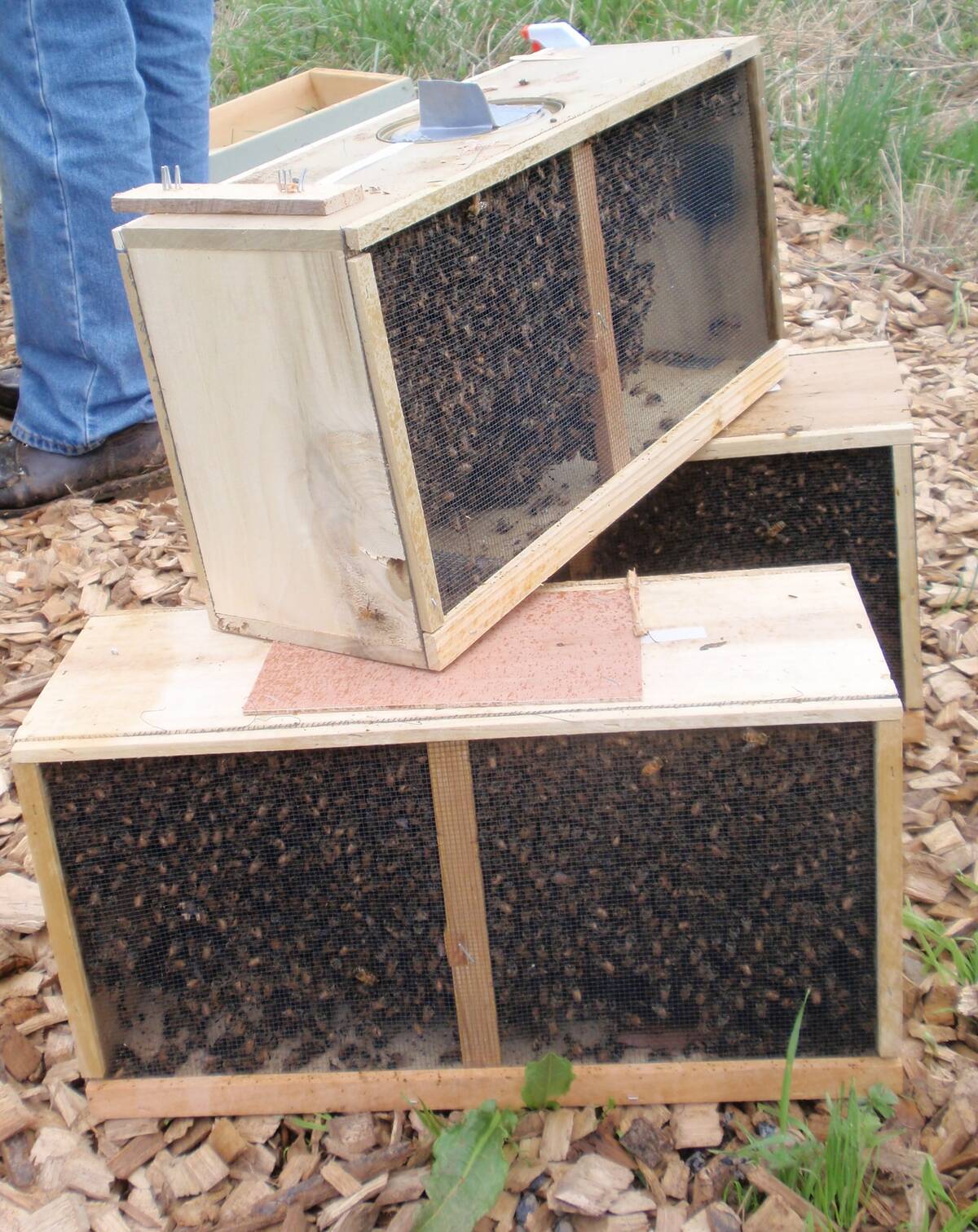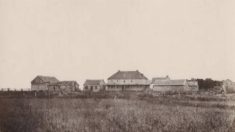If you’ve ever seen the top entries at the Roland Pumpkin Fair giant pumpkin contest and thought, “I’d like to do that,” pumpkin growing experts have some advice for you.
The produce giants were in the spotlight in Selkirk on April 5 for the Giant Pumpkin Growers Seminar.
WHY IT MATTERS: Growing pumpkins to maximum size is not as easy as planting and caring for the typical garden variety pumpkin.
Read Also

Canadian beekeepers call for regulatory accountability
Beekeepers say the Canadian Food Inspection Agency should restore packaged U.S. bee shipments, claiming the agency isn’t following evidence.
Milan Lukes of Winnipeg, a two-time winner for heaviest pumpkin at the Roland Pumpkin Fair was brought in to share his experience. Lukes first won the championship spot in 2015 at just 13 years old, a fact he linked to the surprising accessibility of giant pumpkin growing.
“You don’t need acres and acres. You don’t need to be a farmer,” he said. “You can be a young person from the city and still grow one over a thousand pounds.”
Small seed, big fruit
Pumpkins with championship potential come from very specific seed, attendees heard.
The Dill’s Atlantic Giant pumpkin variety, bred in Eastern Canada by Howard Dill, holds the world record for generating giant pumpkins and has become the go-to seed for hopeful pumpkin champions.
A pack of nine seeds of Dill’s Atlantic Giant sells in Canada for about six dollars.
Much like race horses though, genetic lines with proven championship potential come with a premium cost above and beyond the typical seed market. One seed from the current giant pumpkin record holder sells for nearly $500, Lukes noted.

Giant pumpkin agronomy
Just as in real estate, choosing a location is highly important. While a fully grown giant pumpkin looks formidable, it needs a great deal of shelter earlier in its development. Tarps and snow fence materials are often used as windbreaks when a permanent structure such as a garage or shed may not be nearby.
“These giant pumpkin plants have massive leaves,” Lukes said, “Think of them as solar panels, right? If these leaves are being torn and ripped during the wind, you know your plant won’t be producing as much glucose or as much energy that could be going into that giant pumpkin.”
Lukes added that it’s a good idea to identify the first true leaf on your pumpkin plant so it can be properly oriented before planting. A pumpkin plant will vine out in the opposite direction of its true leaf. Plenty of room is needed for that main vine as it extends and grows.

Growing a giant pumpkin requires a lot of sun, but the pumpkin itself needs to be protected from intense sunlight. Too much sunlight will harden its exterior and impede its ability to stretch as it grows. If the pumpkin splits down into the flesh, it’s no longer competition-worthy.
“We do allow it to have some cracking,” said Laverne Wojciechowski, secretary with the Great Pumpkin Commonwealth. “but the cracks can’t go inside of the fruit because somebody could have put something inside.”
Last but not least, be prepared to use a lot of water.
During peak season in mid-to-late July and August, Lukes used around 378 litres (100 gallons) of water a day to water his two plants and their canopy of leaves.
“Everywhere where there’s a leaf that connects to the main vine, or any vine, the pumpkin plant will actually send out roots,” Lukes said. “By watering the entire canopy, you’re also watering those roots that are on those vines that are 10 feet or more outward. So you’re not just watering and feeding the stump of the crown, but all the roots in that plant system.”
Lukes typically fills a large tank with tap water and lets it sit for a day before watering his pumpkins. This allows the water to warm up and for chlorine to evaporate. Once he finished watering, he refills the tank to prepare for the next day.
All of this takes a considerable amount of time.
Wojciechowski paraphrased comments from the current giant pumpkin world record holder made at a 2024 conference:
“Pumpkin is your life. You do nothing else. It’s 185 days of planning and getting that thing growing and getting it to the weigh-off. So if you want to grow it, you have to focus on that, and just that.”
You’ve grown a giant pumpkin. Now what?
“You want to make sure there’s a soft padding, Lukes said. “You don’t want any cracks or anything when you’re transporting it to the weigh-off. So something that can actually absorb any shock would be beneficial.”
Lukes fashions a system of straps into a sling, while digging out some of the earth below the giant pumpkin to allow lifting it from underneath. It only needs to be lifted high enough for a pallet to slide underneath. Once that’s safely achieved, the giant fruit can be lowered onto the pallet, secured and loaded onto a trailer or truck.

Some growers will retain several feet of vine on their giant pumpkins when trimming it from the garden, Lukes noted. They place these vines in buckets of water, allowing the pumpkin to continue to drink.
“Let’s say you harvest your pumpkin, but the weigh-off is not until the next day or 12 hours later,” Lukes said, “You will still get the pumpkin putting on a few pounds, and every pound matters when you’re trying to go for first place.”
Arthur Cameron, chair of the Manitoba Giant Growers Association and long-time organizer of the Roland Pumpkin fair, said many competitors will scout out their route before loading up their pumpkin and hitting the road to avoid potential shocks.
For an example, last year’s fair winner was from Minnesota and called Cameron to talk about the comparative condition of different Manitoba highways.
While some imperfections in a giant pumpkin are acceptable for competition, any severe damage will likely disqualify it.
“We want to make sure that our fruit is sound and healthy,” Wojciechowski said. “But that being said, you can get damage from mice and we do get hail, and that can create scabs on the fruit … so we do allow for damaged spots of a certain size.”
After the weigh-off
Giant pumpkins are not destined for scores of pumpkin pies — those who have tried say they are not the best edible variety for humans; the flesh is stringy.
In many cases, local wildlife such as deer reap the rewards of a grower’s efforts. Lukes said that, in past years, he’s placed a giant pumpkin on his parent’s front lawn. After about a month, it had been entirely eaten.
But one man has taken a creative, autumn appropriate approach to tap giant pumpkins for a charitable cause.
For the past several years, Chris Okell of Winnipeg has been carving up pumpkins from the Roland Pumpkin Fair as Halloween jack-o’-lanterns in memory of his mother, who died from pancreatic cancer.
In 2024, CBC Manitoba reported in an interview with Okell that his charity, The Pumpkin Promise, had raised over $64,000 for CancerCare Manitoba since 2010.
SIDEBAR: Giant pumpkin central
So how did Roland, Manitoba, get to be pumpkin central for giant pumpkins in Manitoba?
Arthur Cameron, chair of the Manitoba Giant Growers Association, said it’s likely down to one local avid gardener who was born in Roland.
“Probably close to 50 years ago, a man named Edgar VanWyck got interested in growing giant squash and pumpkins,” Cameron said. “He was actually a friend of Howard Dill of Nova Scotia.”
Dill went on to breed one of the go-to giant pumpkin varieties for Canadian growers.
For a number of years during the 1970s, VanWyck showed his giant pumpkins at the Toronto Winter Fair, even earning his name in the Guinness Book of World Records for growing a record-size pumpkin in 1977.
Interest in growing giant pumpkins for the Roland Pumpkin Fair competition has ebbed and flowed, and Cameron has seen fewer growers compete at the weigh-off in the past several years.
“I think what’s happened is we have some very serious growers who are trying to grow those big ones,” Cameron said, “but the people that don’t really want to put that much effort into it aren’t going to be rewarded, so they don’t bother bringing one to the fair.”
Ten cash prizes were awarded at the giant pumpkin weigh-off in 2024. Charlie Bernstrom of Minnesota won that top prize of $1,500 with an eye-popping pumpkin that weighed in at 2,004 pounds (about 909 kilograms), the heaviest ever recorded at the Roland Pumpkin Fair.
















